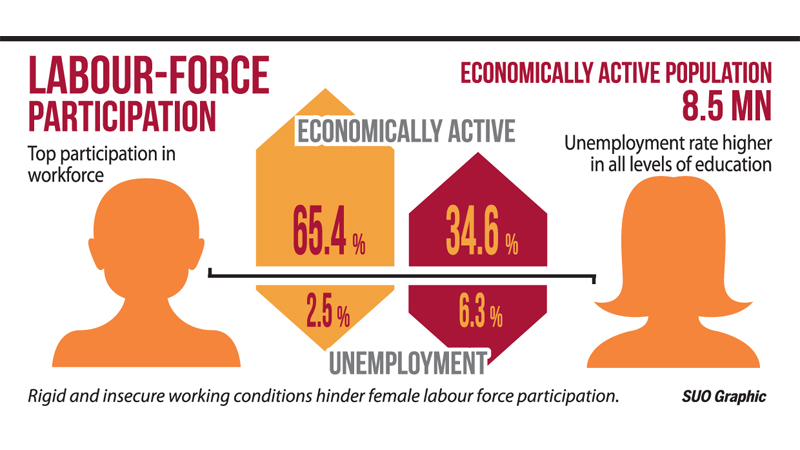- Women are less economically active than men
- Males exceed females in labour force participation in all age groups
- Female unemployment rates are higher than those of males in all levels of education
The disparity in male and female in the country’s labour force participation rate (LFPR) continues indicating a significant gap of the two genders in their contribution to the economy.
A survey by of the Department of Census and Statistics for the first quarter of 2025 reveals that of the estimated economically active population of about 8.5 million in the first quarter this year 65.4 percent are males and 34.6 percent are females.
Of the economically inactive population of about 8.6 million around 27.6 percent are males and 72.4 percent are females.
Considering the distribution of LFPR by age group and gender depicts high male participation compared to female in all age groups. The highest participation rate for males is reported from age group 35 – 39 years (97.1%), while that for females is reported from 50 – 54 age group (49.2%).
The highest unemployment rate is reported from the G.C.E. (A/L) and above group which is 6.1 percent. Corresponding percentages are 4.2 percent and 8.2 percent for males and females respectively. Female unemployment rates are higher than those of males in all levels of education.
Persons, who worked at least one hour during the reference period, as paid employees, employers, own account workers or contributing family workers are said to be employed. This also includes persons with a job but not at work during the reference period.
During first quarter of 2025, the total number of employed persons in Sri Lanka is estimated as 8.1 million of which, about 50.3 percent engaged in service sector, 26.2 percent in industry sector and 23.4 percent in the agriculture sector.
In the first quarter of 2025, there has been an increase in the number of employed persons in the service and industry sectors compared to the first quarter of 2024.
A majority of the workforce are private sector employees followed by own account workers. Non agriculture sector covers 76.6 percent of the employed population in Sri Lanka, employees and own account workers are highly constraining in that sector. The highest employment share is in the service sector and this is true for both male and female, while the lowest shares are for agriculture sector.
Among employed females 21.6 percent are in agriculture sector while this share is 24.4 percent for males.
The overall unemployment rate reported for females is 6.3 percent and it is 2.5 percent for male. Youth unemployment rate (age 15 – 24 years) corresponding to the first quarter 2025 is 19.7 percent and that is the highest reported unemployment rate among all age groups.
The unemployment rates for males and females are 15.0 and 27.3 percent respectively for age group 15 – 24. The survey results further reveals that the unemployment among females is higher than that of males, in all age groups.
Youth and female unemployment contribute more to the overall unemployment of the country.
Citing the Constitution of the country, Emeritus Professor, Chartered Architect/Chartered Quantity Surveyor Chitra Weddikkara said that no citizen should be discriminated on the grounds of race, religion, language, caste, sex, political opinion, place of birth or any such grounds. The fundamental right to equality is not simply a latent right; the State has a proactive role to play in relation to specific groups of its citizens.
She said that a higher female participation rate in the labour force could be achieved by creating a more flexible working environment that enables married women with infants to work from home that would balance work and office responsibilities.









